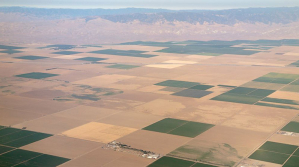
California is currently undergoing a historic drought, which is why the state is forcing its residents to conserve water through drastic measures. However, the rest of the United States could soon feel the impact of the drought too.
According to Michael Martinez and Alexandra Meeks of CNN, the most populous state in the nation grows more than a third of its vegetables and nearly two-thirds of the fruits and nuts. U.S. Department of Agriculture economist Annemarie Kuhns explained how consumers would feel the impact.
"The drought in California does have the potential to impact the price we pay for fresh fruit and fresh vegetables and dairy and fresh eggs we pay at the counter," Kuhns said. "We are not sure what the exact impact will be."
Kuhns claimed to CNN that fresh fruit prices could rise between 2.5 percent and 3.5 percent, while vegetable prices could increase between 2 percent and 3 percent, which are both close to historical average increases. However, she noted that the U.S. dollar is currently strong in the markets, which means producers could import crops to make up for the shortfall.
"What economists don't know yet is whether farmers will plant fewer crops because of the drought," Martinez and Meeks wrote, citing Kuhns. "Those decisions are now being made in the field and could boost supermarket prices."
However, the drought in California is only part of a much larger one affecting the American West and Southwest. CNN cited the U.S. Drought Monitor, which stated that the Western drought affected more than 52 million people, including those living in states such as Texas and Oklahoma.
"Straining under a drought that began in 2012, ranchers in Texas and Oklahoma last year saw smaller grazing pastures, paid more for feed, and experienced difficulties accessing water to cool their cattle," Martinez and Meek wrote.
The USDA reported that consumers paid 12.1 percent more for beef and veal in 2014 thanks to the ongoing drought. CNN, citing the feds, projected that prices for beef and veal could rise by as much as 6 percent; the historical average is around 4.1 percent.
"There's other areas being affected," Kuhns said.
Climatologist Benjamin Cook, who works at the NASA Goddard Institute for Space Studies in New York City, told Tia Ghose of LiveScience that conditions in California could worsen in the coming decades.
"Climate change is going to lead to overall much drier conditions toward the end of the 21st century than anything we've seen in probably the last 1,000 years," Cook said.
However, experts told Ghose that California was "unlikely to become a parched, uninhabitable hellscape." They indicated that the state could plan ahead to have enough water to support the millions of people who live there.
"There are a lot of opportunities to deal with these potentially significant droughts in the future, but we just need to be a little bit proactive about it and we need to plan ahead," Cook said.
Cook argued that the water shortage in California is largely due to agriculture, which uses about 70 to 80 percent of the state's total water. He noted that water-thirsty crops such as almonds and lettuce would have to be replaced by more drought-tolerant crops.
"The state could help subsidize a shift to drip irrigation, which delivers moisture directly to a plant's roots," Ghose wrote, citing Cook.
Despite the attention-grabbing headlines and drier conditions, bioclimatologist A. Park Williams told Ghose that agriculture could become "a less prominent part" of California's economy.
"In the next few decades, warming is not going to cause California to be a wasteland," Williams said.







